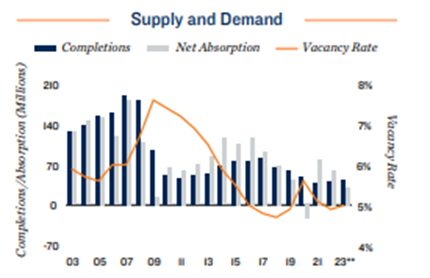2023 Retail Outlook: Slow And Steady Wins The Race
By: Dylan Wolf

Up down or sideways, where are we heading? Bloomberg, CNBC, and every other major news outlets all have something to say. In a business deeply rooted in the founding principles of capitalism, we must follow the money to see what the Retail outlook is in 2023. How do use the data already presented to provide an assumption as to what the national market, debt, and investment trends will do this year?
National Market Trends:
Coming out of the gates hot, retail spending is up over +8.8% year over year in January, according to the Mastercard Spending Pulse, A tracker on nominal spending. However, Inflation has already made its presence felt early in the year. Consumers are having to experience hiked pricing across all necessity spending including housing, food, clothing, etc. This means, if people are pinching pennies and reigning in other personal investments, this would dampen GDP growth in 2023. With a potential slowdown, this directly impacts the labor market. Fewer jobs in general will directly impact unnecessary spending. On the corporate side of things, they have returned to the Pre–pandemic level revenues, however, major hiring freezes and cuts have started to incur. As Marcus and Millichap’s research team said, “firms are expected to limit non-essential business travel, acting as a counterbalance to the positive impacts of higher domestic tourism”. The lack of capital injection from tourism will also hinder the economic growth of 2023.
CAPITAL MARKET OUTLOOK:
As the market braces for the slowdown in consumer spending, the banks are adjusting across the board in terms of lending. Properties are facing maturing debt in an environment of much higher capital costs. That said, across all types of assets, lenders still show favor to necessity retail. This means grocery-anchored centers and single-tenant net leases with long-term leases that carry low risk would be for the lenders. Due to all of this, the narrowing discrepancy between cap rates and interest rates will immediately shift yield-driven buyers to adjust their perception of the market and broaden their criteria. With more risk in other sectors, more buyers will shift their focus to the retail sector with the lack of inventory will make them favor Retail. A great indicator of this is the decline in loan delinquencies in the retail sector. Per John Chang, retail loan delinquency was “Peaking at 9.4 percent in July 2020, loan delinquency for retail properties, excluding malls, has since fallen to about 5 percent of sales” in 2023.
INVESTMENT MARKET TRENDS:

Moving on to the physical asset of the property, throughout the year suburban shopping centers and single tenants with high credit should flourish. In Washington State, especially the Seattle-Tacoma area, the vacancy has fallen below 3%. With people moving back into major cities, urban cores are returning to normal. More apartment development has attracted more people to come back. This helps more urban retail opportunities look appealing. According to Marcus and Millichap Research Team, “Availability bumps down to 2.9 percent as net absorption outpaces supply for the third consecutive year. The vacancy rate will fall 160 basis points below the mean over the past 15 years.” Again, people are going to look for security and Net-Lease assets, which most likely will become very attractive for the capital to be deployed.
It will help exchange groups gain confidence with the “perceived stability” of strong credit retail. Buyers will now look for long-term cash flow and less management as people buckle down for the year. Privatized purchasers will be more focused on the sub 3 million price point to not have to compete with the larger institution owners.
For more information or Inventory, please visit: BrownRetailGroup.com
Or connect with me directly: Dylan.Wolf@marcusmilichap.com / 206.826.8761
Sources: Marcus & Millichap Research Services; Bureau of Labor Statistics; CoStar Group, Inc.; Federal Reserve; Real Capital Analytics; RealPage, Inc.; U.S. Census Bureau
About Marcus & Millichap (NYSE: MMI)
With over 2,000 investment sales and financing professionals located throughout the United States and Canada, Marcus & Millichap is a leading specialist in commercial real estate investment sales, financing, research and advisory services. Founded in 1971, the firm closed 9,726 transactions in 2019 with a value of approximately $50 billion. Marcus & Millichap has perfected a powerful system for marketing properties that combines investment specialization, local market expertise, the industry’s most comprehensive research, state-of-the-art technology, and relationships with the largest pool of qualified investors. To learn more, please visit: www.MarcusMillichap.com.